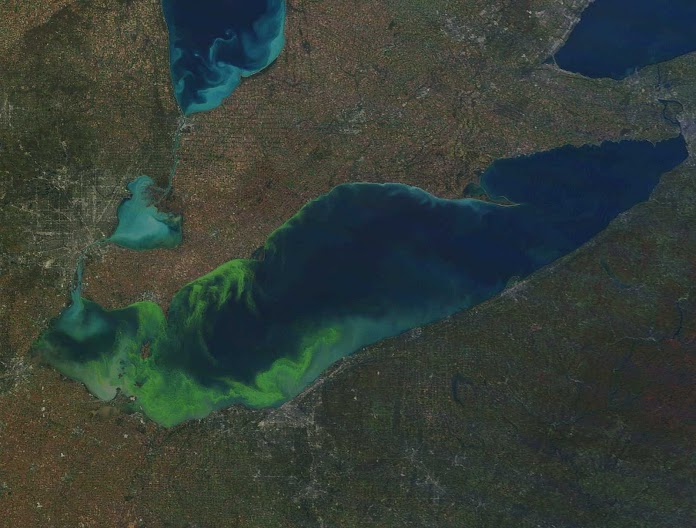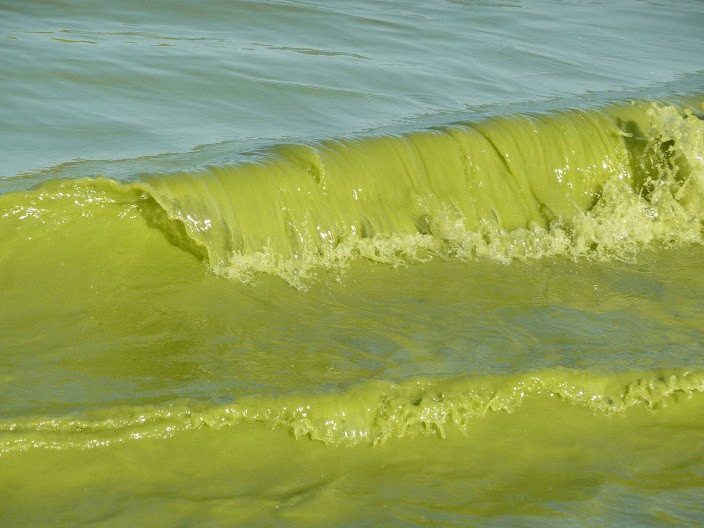Algae bloom, the sequel, spells big trouble for Lake Erie
Given the events of last summer, the bulletin was not exactly comforting.
Lake Erie's 2015 expected algae bloom, the National Oceanic and Atmospheric Administration warned recently, could be “among the most severe in recent years” and rival that of 2011. That's when heavy spring rains washed so much phosphorus into the lake that a fifth of its surface was covered in green slime in October of that year.
This year’s bloom, just beginning to form in Erie’s western basin, is already prompting calls for more stringent actions to be taken by industrial agricultural concerns and others to help reduce phosphorus levels that allow algae to thrive. Beyond clogging beaches with unsightly gunk and threatening municipal water systems that draw from Lake Erie, the blooms spawn vast, oxygen-deprived “dead zones” that choke off marine life along with a tourism industry that generates billions of dollars.
RELATED: Voluntary measures haven’t stopped algae blooms in Gulf of Mexico
Last year at this time, another blue-green algae mess infiltrated Toledo's water system, leaving some 400,000 customers in Ohio and southeastern Michigan without safe drinking water for three days. Algae was sucked into one of the system's intake pipes at the lake bottom, contaminating the water with microcystin, a toxin that can cause liver and kidney damage. Last month, Toledo officials said they detected small amounts of microcystin at its intake cribs, but said the water remained safe to drink.
What’s just as discomforting going forward, experts say, is that the increase in blooms in recent years has no apparent end in sight.
“Do I expect that we are going to see a big reduction in algae blooms in the next two or three years? No,” said Laura Rubin of the Ann Arbor-based Huron River Watershed Council, a nonprofit advocacy group that monitors the Huron River watershed that empties into Lake Erie between Wayne and Monroe counties.
“I think it's going to take 20 years or more and it's going to take more regulation. I have not seen the commitment from agriculture that I think is necessary.”
Researchers say that curbing phosphorus-rich agricultural fertilizer runoff ‒ perhaps through federally-imposed limits ‒ is key to halting these toxic blooms, since it comprises more than half the algae-feeding nutrients that flow into the lake. Voluntary measures have thus far failed to curtail that runoff, even as agricultural groups resist calls for tighter regulation of farming.
But Brad Wurfel, spokesman for Michigan’s Department of Environmental Quality, said Michigan’s agricultural conservation efforts aren’t the problem, saying, “The problem is far more complex than this narrative of blaming Michigan farmers.”
Renewing a battle
The Great Lakes’ battle with the blooms was a saga that many in the Midwest thought had been solved through landmark environmental legislation in the 1970s.
“We've done the easy things,” said Sean Hammond of the Michigan Environmental Council, a Lansing nonprofit advocacy group. He was referring to measures taken to improve Lake Erie’s waters under the Clean Water Act of 1972, including the upgrade of sewage treatment plants and elimination of phosphates from soaps and laundry detergent.
“This isn't the low-hanging fruit of the 1970s when all we had to do was stop rivers from burning,” he said. “We have to have a full effort from all sectors, urban, suburban and agricultural. This is really the biggest issue facing the lakes right now.”
The stakes are considerable, given that the Great Lakes contain about 20 percent of the world's fresh water.
With about 70 percent of the land along Lake Erie’s western basin, much of it farmland, Ohio contributes most of the phosphorus that reaches the basin. But Michigan, with 18 percent of the watershed's land, and Indiana, with 12 percent, are contributors as well. Overall, an average of about 10,000 tons of phosphorus reaches the lake each year, more in years of heavy rain.
Gov. Rick Snyder acknowledged the issue in June at the Great Lakes governor’s Leadership Summit in Quebec, when he joined with other Great Lakes governors on a resolution aiming at a 40 percent decrease in phosphorus that runs into the western basin of Lake Erie by 2025. It is a steep reduction, but one that environmental experts deem necessary to restore the lake to health.
There's one missing ingredient: Specifics. The resolution offers nothing more concrete than commitment to a yet-to-be-devised plan to reach that goal.
 At its peak, the 2011 algae bloom on Lake Erie covered a fifth of the lake's surface. (Photo credit: National Oceanic and Atmospheric Administration.)
At its peak, the 2011 algae bloom on Lake Erie covered a fifth of the lake's surface. (Photo credit: National Oceanic and Atmospheric Administration.)
A 78-page report issued in June by several Michigan state agencies, “Sustaining Michigan's Water Heritage,” highlights the issue as well. But it is no more specific about solutions. On the issue of algae blooms, it recommends: “Develop a comprehensive strategy to prevent nuisance and harmful blue green algal blooms. Achieve a 40 percent phosphorus reduction in the western Lake Erie basin.”
Last week, Michigan conservation and agricultural leaders announced a partnership aimed at addressing the issue, calling for more research and encouragement of voluntary conservation practices by agriculture. Whether it makes a dent in the problem remains to be seen.
“Doing the same things we've done in the past will not solve the problem,” said Jim Byrum of the Michigan Agri-Business Association, which is joining with the Michigan League of Conservation Voters in the partnership.
No surprise
The outlines of the problem have been evident for years, well before the headline-grabbing algae blooms of 2011 and 2014.
A 2010 report by the Ohio Lake Erie Task Force, comprised of state and federal officials, academic experts and representives of the agricultural sector, noted that extensive algae blooms were common in the 1960s and 1970s. It credited the Clean Water Act with making the lake healthy again.
But the 2010 report noted that blue-green algae blooms, different from the green algae blooms of the 1960s, began to appear in the 1990s, with a “massive bloom” in 2003 and “particularly extensive blooms” in 2007 and 2008. The report ties these blooms to rising amounts of dissolved phosphorus reaching the lake, the introduction of zebra and quagga mussels, which altered the lake’s ecosystem, and heavy rainstorms that may be linked to climate change.
In recent years, blooms appeared in Saginaw Bay and Green Bay as well. Scientists say the blooms also contribute to the growth of marine dead zones ‒ where few fish can live ‒ as decomposing algae use up oxygen in the water.
In a key finding, the report noted that dissolved phosphorus is of “particular concern because it is almost 100 percent bioavailable” to blue-green algae. Translation: Dissolved phosphorus is like Superfood to algae.
Farming becomes a target
Experts identify agriculture as the biggest culprit, as fertilizer washes off corn and wheat fields and industrial-sized livestock operations into ditches, streams, tributaries and ultimately the rivers that drain into Lake Erie. The shallow western basin is particularly vulnerable to algae blooms because of its warm waters and average depth of just 24 feet, compared with 62 feet for the entire lake.
And though cities in the watershed have significantly reduced the levels of sewage that reach Lake Erie since the 1970s, a single storm in 2014 revealed how much remains to be done. According to analysis of DEQ data by the Detroit Free Press, 10 billion gallons of sewer overflows emptied into southeastern Michigan waters on Aug. 11, 2014, much of that reaching Lake St. Clair or flowing directly into Lake Erie.
Don Scavia, an aquatic ecologist and director of the University of Michigan’s Graham Sustainability Institute, said he wonders just how much the cleaner the lake can get as long as basic agricultural practices and crops grown in the Lake Erie basin remain as they are.
“One has to ask the question: Are these watersheds so overwhelmed by industrial corn and soybeans operations that we have to change not the just way we grow, but consider the need to grow something different?”
Scavia said changes in farming practices over the decades appear to be a key contributor to the rise in dissolved phosphorus.
Many farmers have turned to no-till growing as a means to slow soil erosion. But instead of churning fertilizer into the ground, where it binds with soil, no-till growing leaves fertilizer on the surface of the soil to be absorbed by the plants. Heavy rains can wash away the fertilizer before it is absorbed.
And as more farms have become industrial operations, it is more common to apply fertilizer in late fall, when the ground is firm enough for large machinery. That fertilizer may still be on the surface when the next hard rain falls, washing it into the lake.
There is evidence as well that invasive species play a role in the spread of toxic blue-green algae, the type that struck Lake Erie in 2011 and 2014.
Researchers say that zebra and quagga mussels, which came from overseas in the late 1980s in the ballast of ships and soon spread through the Great Lakes, boost the spread of this algae. The mussels eat non-toxic green algae, but they avoid blue algae.
That leaves lakes like Lake Erie with disproportionate amounts of blue-green algae. All it needs is a food source – phosphorus – to explode.
To date, efforts to reduce agricultural phosphorus have been almost entirely voluntary.
Carrot or stick
In January, the U.S. Department of Agriculture announced a grant of $17.5 million to encourage farmers in Ohio, Indiana and Michigan to adopt conservation practices designed to keep nutrients on the field instead of in the lake. The grant is distributed to states based on the amount of land they have within the Lake Erie basin, with Ohio receiving $12.25 million, Michigan $3.15 million and Indiana just over $2 million.
The funds are to be spread over five years, paying farmers to plant cover crops, grow grass buffer barriers, install drainage water management devices and animal waste storage structures and adopt other management practices. But those funds will likely reach only a tiny fraction of the thousands of farmers in the Lake Erie basin.
After years of pressure from environmental groups, Ohio took a step toward telling – rather than asking – farmers what to do on their farms. In April, Ohio Gov. John Kasich signed legislation banning farmers from applying fertilizer to frozen fields, a practice that environmental advocates say will reduce fertilizer runoff.
In 2014, the International Joint Commission, a United States-Canadian water use planning body, issued a recommendation that the province of Ontario as well as Michigan, New York, Pennsylvania and Indiana ban that practice as well. It also recommended:
Stronger agricultural regulatory mechanisms, including tying federal crop insurance to the adoption of conservation practices.
That Ohio and Michigan place Lake Erie on the “impaired” waters list under the Clean Water Act, which would force states in the watershed to find ways to meet more stringent phosphorus limits for the western Lake Erie basin. Enforcement would come from the U.S. Environmental Protection Agency.
That Ontario, Ohio and Pennsylvania prohibit the sale and use of phosphorus fertilizer for lawn care. Michigan banned its use, except for starter lawns, in 2012.
Wurfel, the Michigan Department of Environmental Quality spokesman, said in January that Michigan's voluntary approach to agricultural conservation is working. In 2011, Snyder signed two bills into law, expanding a voluntary program to help farmers adopt conservation practices and rewarding those who meet certain standards with less oversight and protection from some legal liabilities.
Wurfel pointed to a state study of Michigan farms in the Lake Erie watershed, that showed farms participating in a voluntary conservation program cut phosphorus use and runoff by about 62,000 pounds from 2011 to 2013. But that’s only about one-third of 1 percent of the average annual total of phosphorus reaching the lake from all sources.
In a statement to Bridge, Wurfel rejected the proposal to declare Lake Erie impaired: “There is no way the state would take that action yet, for three reasons. One, there are no support studies completed that would buttress that determination. Two, Michigan has already done a ton to reduce phosphorus inputs to the lake, and we’re doing more all the time.”
Asked if Michigan should adopt Ohio’s ban of applying fertilizer on frozen fields, Wurfel indicated that Michigan has discouraged that practice for years.
Any attempt to declare Lake Erie impaired seems sure to stir opposition from agricultural and industry industry groups, given the fight over cutting pollution into Chesapeake Bay, which borders Virginia and Maryland and has been plagued by dead zones and algae blooms for years.
In July, a federal appeals court upheld the right of the EPA to establish limits under the Clean Water Act for how much nitrogen, phosphorus and sediment can enter the bay each year. The cleanup plan has been opposed by agriculture groups including the the Fertilizer Institute, the National Pork Producers Council and the American Farm Bureau Federation, which sued the EPA over the issue in 2011.
Lana Pollack, chair of the three-member U.S. delegation on the International Joint Commission, asserted that it is clear that voluntary measures are not enough to clean up Lake Erie. She served as Democratic state senator from 1983 to 1994 and was president of the Michigan Environmental Council from 1996 to 2008.
“We need regulations. Volunteerism alone is not working,” Pollack said.
“We don't let most people decide whether they are going to pollute or not pollute public waters. Although we have industrial farming (in the Lake Erie basin) we have very much this mindset of the old family farmer working a few acres, instead of industrial farm operations with thousands of acres.”
“Ohio has taken some first steps,” she said, referring to its ban on applying fertilizer on frozen ground. “Michigan has not.”
See what new members are saying about why they donated to Bridge Michigan:
- “In order for this information to be accurate and unbiased it must be underwritten by its readers, not by special interests.” - Larry S.
- “Not many other media sources report on the topics Bridge does.” - Susan B.
- “Your journalism is outstanding and rare these days.” - Mark S.
If you want to ensure the future of nonpartisan, nonprofit Michigan journalism, please become a member today. You, too, will be asked why you donated and maybe we'll feature your quote next time!


 Rolling in green on Lake Erie (Photo credit: National Oceanic and Atmospheric Administration)
Rolling in green on Lake Erie (Photo credit: National Oceanic and Atmospheric Administration) Lana Pollack, chair of the three-member U.S. delegation on the International Joint Commission, advocates tougher regulation of agriculture to save Lake Erie. (Photo credit: International Joint Commission.)
Lana Pollack, chair of the three-member U.S. delegation on the International Joint Commission, advocates tougher regulation of agriculture to save Lake Erie. (Photo credit: International Joint Commission.)